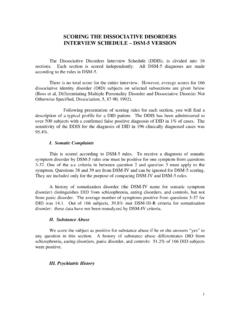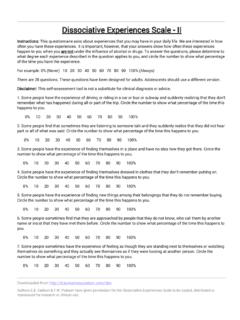Transcription of Review Article Dissociation Following Traumatic Stress
1 Review ArticleDissociation FollowingTraumatic StressEtiology and TreatmentMaggie Schauer and Thomas ElbertDepartment of Psychology, University of Konstanz, postulate that the cascade Freeze-Flight-Fight-Fright-Flag-Faint is a coherent sequence of six fear responses that escalate as afunction of defense possibilities and proximity to danger during life-threat. The actual sequence of trauma-related response dispositions acted outin an extremely dangerous situation therefore depends on the appraisal of the threat by the organism in relation to her/his own power to act ( ,age and gender) as well as the perceived characteristics of threat and perpetrator. These reaction patterns provide optimal adaption for particularstages of imminence. Subsequent to the Traumatic threats, portions of the experience may be replayed. The actual individual cascade of defensestages a survivor has gone through during the Traumatic event will repeat itself every time the fear network, which has evolved peritraumatically,is activated again ( , through internal or external triggers or, , during exposure therapy).
2 When a parasympathetically dominated shut-down was the prominent peri- Traumatic response during the Traumatic incident, comparable dissociative responses may dominate responding tosubsequently experienced threat and may also reappear when the Traumatic memory is reactivated. Repeated experience of Traumatic Stress formsa fear network that can become pathologically detached from contextual cues such as time and location of the danger, a condition which manifestsitself as posttraumatic Stress disorder (PTSD). Intrusions, for example, can therefore be understood as repetitive displays of fragments of theevent, which would then, depending on the dominant physiological response during the threat, elicit a corresponding combination of hyperarousaland Dissociation . We suggest that trauma treatment must therefore differentiate between patients on two dimensions: those with peritraumaticsympathetic activation versus those who went down the whole defense cascade, which leads to parasympathetic dominance during the trauma anda corresponding replay of physiological and dissociative responding, when reminded.
3 The differential management of dissociative stages( fright and faint ) has important treatment : Dissociation , complex trauma, PTSD, sexual abuse, borderline personality disorder, tonic immobility, faintingA coherent mental structure requires organized and intercon-nected representations of salient external and internal events,including sensory perceptions, affective and behavioralresponding, and the conscious implications of a given con-text in terms of meaning (Marmar, Weiss, & Metzler, 1998;Van der Hart, Nijenhuis, Steele, & Brown, 2004; Schauer,Neuner, & Elbert, 2005). Experience of overwhelming threatmay interfere with the process of integrating active elementsof sensation, emotion, and cognition into the particulardeclarative memory of the event and thus result in disordersof the trauma spectrum (Brewin, 2001; Conway & Pleydell-Pearce, 2000; Ehlers & Clark, 2000; Elbert, Rockstroh,Kolassa, Schauer, & Neuner, 2006; Schauer et al., 2005;Van der Kolk, McFarlane, & Weisaeth, 1996).
4 When laterconfronted with trauma reminders, survivors typically replay their original response of the Traumatic event( , Keane, Zimering, & Caddell, 1985). When a parasym-pathetically dominated shut-down was the prominentperitraumatic response to the Traumatic incident, comparabledissociative responses may dominate responding to subse-quently experienced threat and may also reappear whenthe Traumatic memory is reactivated, such as during script-driven imagery (Lang, Bradley, & Cuthbert, 1998) ortrauma-focused treatment (Schauer & Elbert, 2008). Strongdissociative reactions that may even include fainting obvi-ously prevent the success of therapeutic measures thatattempt to integrate the trauma memory into the autobio-graphic narrative and hence pose a serious obstacle to suc-cessful treatment of disorders of the trauma of trauma-focused therapy, these patients thereforetypically receive skill-training, for example, how to identifyand avoid potential triggers that induce detachment or how toend dissociative responding once it has been clinical practice adds to a varying degree elementsfrom dialectic behavior therapy (Hunter et al.)
5 , 2005; Linehan,1993). Unfortunately, these strategies are not sufficient rem-edies for patients with trauma-related dissociative symptoms(Dyer, Priebe, Steil, Kru ger, & Bohus, 2009) and clinical tri-als have identified dissociative symptoms as predictive for anegative treatment outcome (Spitzer, Barnow, Freyberger, &Grabe, 2007). This is not surprising, since Dissociation pre-vents emotional processing and learning (Ebner-Priemeret al., 2009) due to the shut-down symptomatology typi-cally characteristic of dissociative states (Simeon, Guralnik,Knutelska, Yehuda, & Schmeidler, 2003, p. 93).The current concept of posttraumatic Stress disorder(PTSD) does not distinguish whether the reminder of thetraumatic experiences results in a fight-flight alarm response 2010 Hogrefe PublishingZeitschrift fu r Psychologie / Journal of Psychology2010; Vol. 218(2):109 127 DOI: in a dissociative block of sympathetic arousal with asubsequent excessive vagal tone. However, Foa, Riggs,and Gershuny (1995) noted that different PTSD symptomssuch as intense hyperarousal versus numbing may representdistinct pathological processes and that grouping PTSD sub-jects with different symptom patterns in the same diagnosticcategory may interfere with our understanding and treatmentof post-trauma psychopathology.
6 Bremner et al. (1999) sug-gested that there might be two subtypes of trauma responses,one characterized by intrusive memories and hyperarousaland the other predominately dissociative. Results reviewedby Lanius, Bluhm, Lanius, and Pain (2006) indicate thatcomparable patterns may indeed be seen in the neuroimaginglaboratory: Key brain areas involved in the hyperarousalresponse include the anterior cingulate and surrounding med-ial prefrontal cortex, the amygdala and possibly the thalamus,while higher-order sensory association cortices are activeduring dissociative responses. Based on our own observa-tions (Kolassa & Elbert, 2007; Kolassa et al., 2007; Rayet al., 2006), we assume that these abnormal activationpatterns in parietal and occipital cortex might be driven byabnormalities in the temporal cortex and possibly limbicstructures. In a meta-analysis of psychophysiological find-ings in PTSD, Pole (2007) acknowledges the weak consis-tency of psychophysiological responding and suggests thatgreater consideration be given to subtyping of Dissociation Withinan Evolutionary-Based Frameworkof Mental DisordersDissociationwas introduced as a term into psychiatryalready at the end of the 19th century (Janet, 1889; Putnam,1989), however, a conclusive, coherent conceptualizationhas not yet been eved.
7 Experts note that conceptual clarityregarding trauma-related Dissociation is urgently needed (Van der Hart, Nijenhuis, Steele, & Brown, 2004). Despitethe appreciated clinical significance of Dissociation , thereis an ongoing controversy about its theoretical lacks a single, coherent all investigatorsin the field embrace (Cardena, 1994), and it still doestoday: there is no consistent agreement about preciselywhat Dissociation is .. Dissociation represents a semanti-cally open term leading to conceptual confusions which in turn might restrict its value (Spitzer, Barnow, Freyber-ger, & Grabe, 2006). The field is obviously hampered by amissing etiological model (Dutra, Bureau, Holmes, Lyubc-hik, & Lyons-Ruth, 2009). We propose that an evolution-ary-based understanding of mental disorders (Brune, 2002;Jones & Blackshaw, 2000; Wakefield, 1992, 1999) permitsto sort different theoretical approaches and thus facilitatesthe etiological modeling of such behavior.
8 Such progresswould especially be helpful for the development of effectivetherapeutic interventions; it would guide the therapist s mea-sures when confronted with a client with the potential ofsevere dissociative responding, and it thus would overcomethe Dissociation -related obstacles during the course oftrauma-focused evolutionary perspective suggests that Dissociation ,albeit hazarding the consequences of physical injury, is anadaptive, and when strike is close, final remaining survivalresponse to specific types of life-threats that include near-ness of a superior perpetrator or other situations dominatedby helplessness. Dissociation enables survival in the follow-ing situations: when the organism is in direct and close encounter witha dangerous perpetrator, for example, when there is skincontact; in the presence of body fluids with danger of contami-nation, for example, blood or sperm; when bodily integrity is already injured, for example,invasion, penetration, sharp objects ( , teeth andknife) at the situations require physiological adaptations,including immobility, pain tolerance and with it switches in consciousness, information processing, and behavior thatare perceived as strange, because they are outside the rangeof ordinary has equipped us with a defense armament toimminent threat.
9 A coherent sequence of defenseresponses that escalate as a function of proximity to dan-ger and threat has been established by evolutionary biol-ogy and psychophysiology alike. It seems that the defenseprocess is a chain-linking sequence of steps that build oneach other like a cascade. Obviously the animal andhuman organism is able to orchestrate its survival strategyaccording to the specific situation and along a staged pro-cess, called defense cascade (Lang, Davis, & O hman,2000). During life-threat, not every stage of the defensecascade is necessarily passed through by the actual sequence of trauma-related response disposi-tions carried out in an extremely dangerous situation isdynamic and depends on several factors. It is known thatdefensive reflex reactivity is organized sequentially toallow optimal responding depending on the proximity ofthe threat (Bradley, Codispoti, Cuthbert, & Lang, 2001;Fanselow & Lester, 1988) and with it its speed ofapproach.
10 In addition, a particular response may be clas-sically conditioned and thus depends on previous experi-ences with threatening events (Adenauer, Catani, Keil,Aichinger, & Neuner, 2009). Moreover, we propose thatdefense reactivity is organized to account for battlesome-ness (chances to win a fight) of the threatened individual,that is, the appraisal of the threat by the organism in rela-tion to its own power to counteract (age, gender, physicalcondition, defensive abilities, etc.) and, not least, for thethreat-specifics (type of threat, type and speed ofapproach, context, threat involving blood loss, etc.).Whereas the dynamics of the defense cascade progressesin gradients of alternating ascending and descending acti-vation, the various defense responses can be categorizedinto two general forms, namely active defense and immo-bility (Vila et al., 2007).110M. Schauer & T. Elbert: Dissociation Following Traumatic StressZeitschrift fu r Psychologie / Journal of Psychology2010; Vol.






